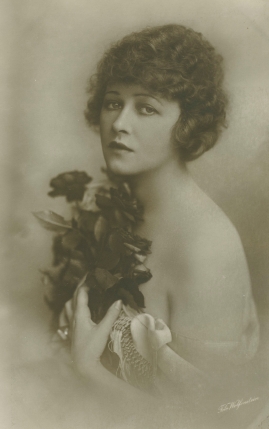Anna Q. Nilsson
Table of contents
- Basic facts
- Links and resources
- Biography
- Awards
- Films
- Original work
- Soundtrack listing
- Groups
Basic facts
Media (1)
| Alternative names |
|
|---|---|
| Cast |
|
Biography
Swedish-American actress. Born as Anna Quirentia Nilsson in Ystad, Scania. Died in Hemet, California.-In a famous scene in Billy Wilder's 1953 film Sunset Blvd. Anna Q. Nilsson is playing bridge with Gloria Swanson, Buster Keaton and H.B. Warner. In this short scene William Holden forsakes his leading role and sits on the sidelines observing a living wax museum of old film stars. This nod to the early days of Hollywood may well go unnoticed by many viewers today. But the fact remains that the scene provides a direct historical link to the birth of the...
Links and resources
Biography
Swedish-American actress. Born as Anna Quirentia Nilsson in Ystad, Scania. Died in Hemet, California.
-
In a famous scene in Billy Wilder's 1953 film Sunset Blvd. Anna Q. Nilsson is playing bridge with Gloria Swanson, Buster Keaton and H.B. Warner. In this short scene William Holden forsakes his leading role and sits on the sidelines observing a living wax museum of old film stars. This nod to the early days of Hollywood may well go unnoticed by many viewers today. But the fact remains that the scene provides a direct historical link to the birth of the American film industry, a history in which the Swedish actress occupies a fully justified place alongside names such as Keaton, Swanson and DeMille.
With her unusual middle name Quirentia, Anna Nilsson nurtured dreams of America as she was growing up in southern Sweden at the turn of the 20th century. After a short while working as a shop assistant, she set sail across the Atlantic and secured a job as a nanny in New York.
While taking a walk in Manhattan she was discovered by the portrait painter Carroll Beckwith, and soon began to pose as a model for the city's finest fashion magazines. The first film stars began to emerge around this time, and some of Nilsson's colleagues had already made their screen debuts. Her own turn came with her 1911 debut as a legendary heroine from the American Revolutionary War in Molly Pitcher (directed by Sidney Olcott) for the Kalem film company. Guy Coombs, her first screen husband, also became her husband in real life, but their marriage only lasted for three years.
Anna Q. quickly established herself as a poster girl for Kalem. Between 1911 and 1919 she appeared in over 100 films. Her face graced the pages of star-making magazines such as Moving Picture World and Photoplay. But as so often with early cinema history, the perishability of nitrate and the negligence of film companies have conspired to ensure that the majority of those films have been lost. Among those that remain are Seven Keys to Baldpate (Hugh Ford, 1917), in which Anna Q. played opposite a young Elda Fury, who subsequently changed both career direction and her name to become Hedda Hopper, one of Hollywood's most powerful gossip columnists. And just like Nilsson, Hopper also appears playing herself in Sunset Blvd.
In 1921 Anna Q. went back to Sweden for the summer just as Erik Petschler was about to begin filming the populist comedy Värmlänningarna ('The Värmlanders,' UK title: Harvest of Hate). When the international star's return became known, Rosa Tillman - set to star in the film - was promptly demoted to a supporting role and Anna Q. was cast in her place. One of the major box-office successes of the 1920s, this was to be Nilsson's only Swedish film. The newspaper Stockholmstidningen praised her talent, divining its roots in her rural upbringing: "It appears that Anna Q. Nilsson finds herself entirely at home in her simple, farm-girl nature, transported in time to earlier, carefree days."
Back in Hollywood her successes continued. In 1923 she appeared in the second version of Rex Beach's box-office hit The Spoilers and in Frank Lloyd's 1925 film The Winds of Chance. But her fortunes suddenly turned. In 1926 she was injured so badly in a riding accident that she was unable to work effectively for several years. Towards the end of the silent era she attempted a comeback and was handpicked by Joseph Kennedy as a star for his newly founded RKO Pictures. But the gradual introduction of the talkies and widening standardisation made the American film market increasingly difficult to manoeuvre for an actress whose public persona was already in the process of being forgotten.
From the early 1930s to the mid 1950s Anna Q. took part in some 40 or so films, although the roles she played finally became so obscure that her name got no mention in the credits. Despite this she managed, even during this period, to appear in a number of classics such as They Died with Their Boots On (Raoul Walsh, 1941) and An American in Paris (Vincente Minnelli, 1951).
With her appearance at that bridge table in Sunset Blvd., her career acquired a radiant, poetic dimension. At the same time, the performance also set the predominant tone for her posthumous reputation. For Anna Q. Nilsson this role as a former film star became the very one for which she is perhaps best known.
Kim Fahlstedt (2015)
(translated by Derek Jones)
Films
| Cast |
|
|---|

